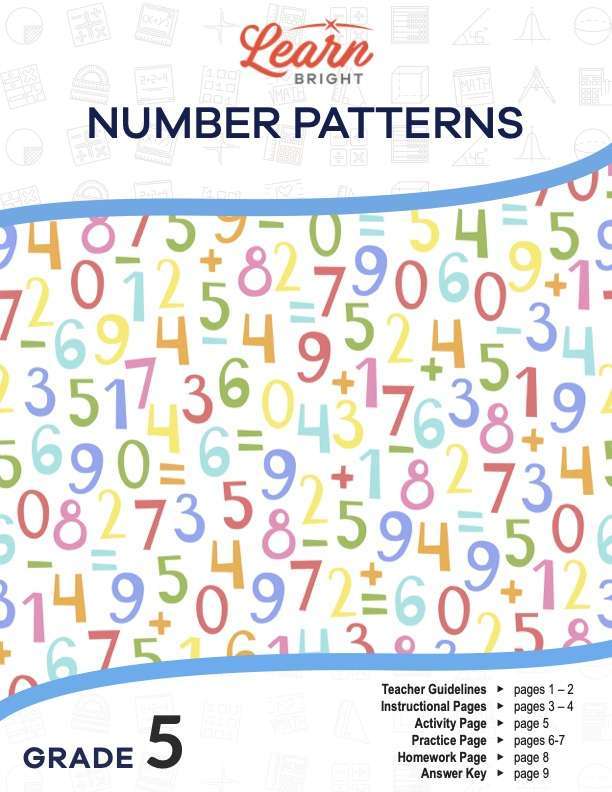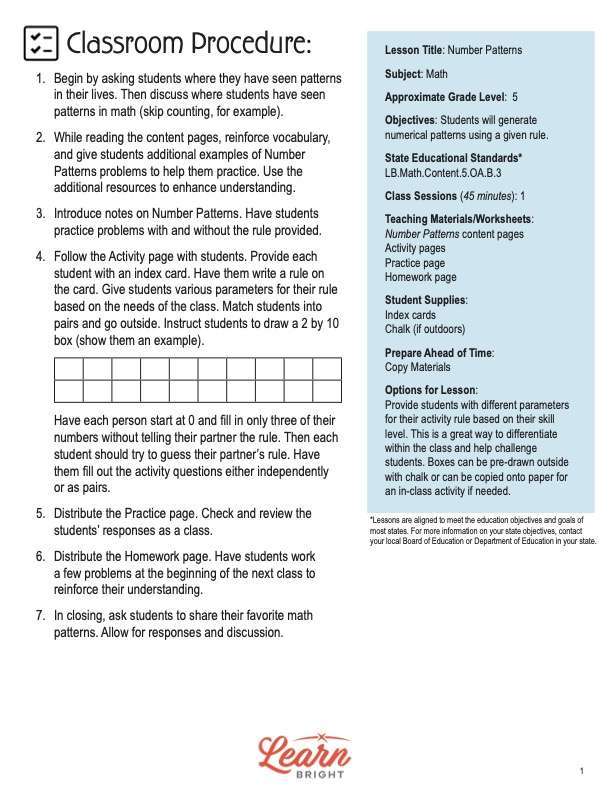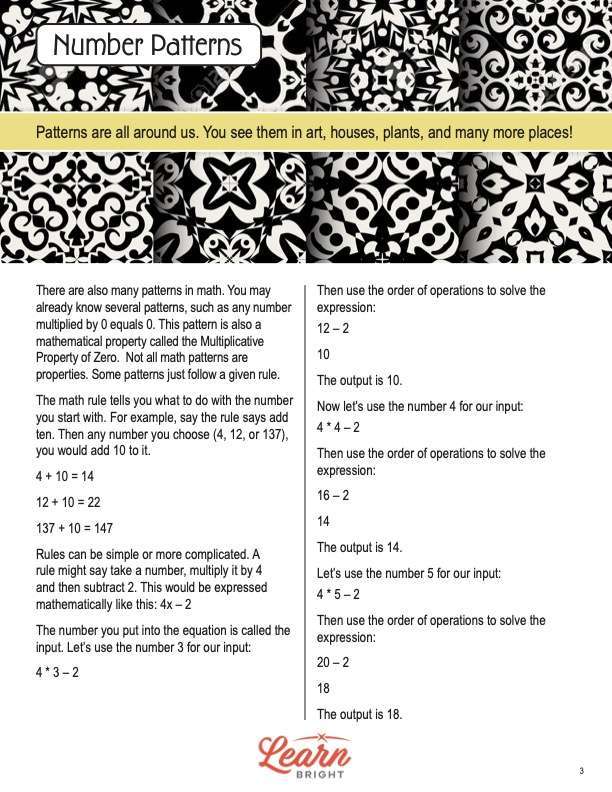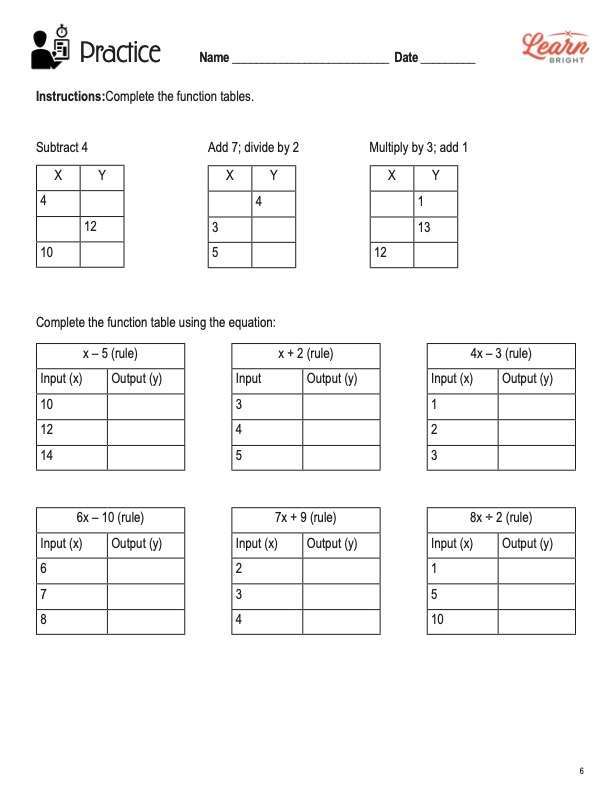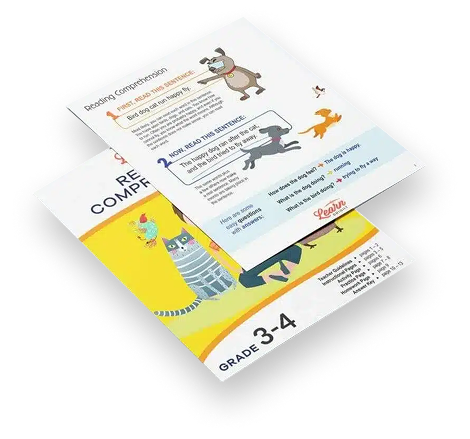Description
What our Number Patterns – Grade 5 lesson plan includes
Lesson Objectives and Overview: Number Patterns – Grade 5 teaches students how to generate patterns using a given rule. You will begin the lesson by asking students where they’ve seen patterns. This can be in general, not necessarily in math. You can also ask about math patterns specifically, such as skip counting. At the end of the lesson, students will be able to generate numerical patterns using a given rule. This lesson is for students in 5th grade.
Classroom Procedure
Every lesson plan provides you with a classroom procedure page that outlines a step-by-step guide to follow. You do not have to follow the guide exactly. The guide helps you organize the lesson and details when to hand out worksheets. It also lists information in the blue box that you might find useful. You will find the lesson objectives, state standards, and number of class sessions the lesson should take to complete in this area. In addition, it describes the supplies you will need as well as what and how you need to prepare beforehand. The supplies that you will need for this lesson include index cards and chalk (if completing the lesson activity outside).
Options for Lesson
Included with this lesson is an “Options for Lesson” section that lists a number of suggestions for activities to add to the lesson or substitutions for the ones already in the lesson. All of the optional adjustments are related to the lesson activity. For the activity, you could provide students with different parameters for their activity rule based on their skill level, differentiating within the class and helping challenge students. You can also pre-draw the boxes outside with chalk or copy them onto paper for an in-class activity if needed.
Teacher Notes
The teacher notes page includes a paragraph with additional guidelines and things to think about as you begin to plan your lesson. This page also includes lines that you can use to add your own notes as you’re preparing for this lesson.
NUMBER PATTERNS – GRADE 5 LESSON PLAN CONTENT PAGES
Number Patterns
The Number Patterns – Grade 5 lesson plan includes two content pages. Patterns are all around you! You can find them in art, houses, plants, and more. Math also has many patterns. For example, you know that any number multiplied by 0 equals 0. This pattern is the mathematical property that we call the Multiplicative Property of Zero. However, not all math patterns are properties.
Math rules tell you what to do with the number you’re given. For example, if the rule is to add ten, you would add ten to any number you start with. If you start with the number four, you would add ten: 4 + 10 = 14. If you start with 12, you add ten: 12 + 10 = 22. And if you start with 137, you add ten: 137 + 10 = 147.
Some math rules are simple and some are complicated. A rule might tell you to multiply by four and then subtract two. We could write this mathematically as 4x – 2. We call the number that you put into the equation the input. Let’s use the input 3 for the math rule 4x – 2 = 4(3) – 2 . We can then use the order of operations to solve the expression: 4(3) – 2 = 12 – 2 = 10. In this case, 10 is the output.
We can also use another number as the input. Let’s try using 4 as our input: 4(4) – 2 = 16 – 2 = 14. 14 is the output. We can also try 5: 4(5) – 2 = 20 – 2 = 18. 18 is the output.
Next, we can take all of these inputs and outputs and create a table, with the input (x) in the left column and the output (y) in the right column. This helps us see all of the data at a glance and start identifying patterns.
You won’t always be given a rule and inputs and asked to find the outputs. Sometimes, you’ll be given a set of inputs and outputs and asked to figure out what the rule is. For example, say you’re given 1, 5, and 12 as inputs and 6, 10, and 17 as outputs. We can see that each time a number goes through the rule, it increases by 5. Therefore, the rule is x + 5.
As another example, say you’re given 2, 3, and 4 as inputs and 5, 7, and 9 as outputs. In this case, there are two operations at work. You multiply by 2 and add 1 to get the output. This is written mathematically as 2x + 1. A little trickier but solvable once you know how to find patterns!
NUMBER PATTERNS – GRADE 5 LESSON PLAN WORKSHEETS
The Number Patterns – Grade 5 lesson plan includes three worksheets: an activity worksheet, a practice worksheet, and a homework assignment. You can refer to the guide on the classroom procedure page to determine when to hand out each worksheet.
CREATE A NUMBER PATTERN ACTIVITY
Students will work with a partner to complete the activity worksheet. Each student will write their own number pattern (rule) on an index card. They will write out the first few numbers for their partner. After switching cards, the students will try to guess each other’s patterns. Then they will fill in the blanks once they know the rule.
At the end, students will answer questions about the patterns they looked at. Some will ask about the pattern of a single rule. Others will ask to compare the patterns of the two sets of numbers to each other.
NUMBER PATTERNS – GRADE 5 PRACTICE WORKSHEET
The practice worksheet provides several function tables. The students will have to determine the patterns based on the numbers in the table. The tables present both X and Y (input and output) values with which students can learn the rules. The tables get progressively more difficult to test students’ comprehension.
WORD PROBLEM HOMEWORK ASSIGNMENT
The homework assignment asks students to analyze a table with two different rules. They will answer questions about each rule and compare them to each other. Afterward, they will have to create a pattern based on a given rule. Finally, they will describe how they came up with their new patterns.
Worksheet Answer Keys
This lesson plan includes answer keys for the practice worksheet and the homework assignment. If you choose to administer the lesson pages to your students via PDF, you will need to save a new file that omits these pages. Otherwise, you can simply print out the applicable pages and keep these as reference for yourself when grading assignments.

